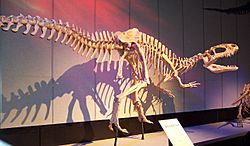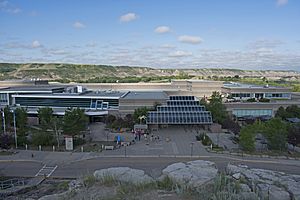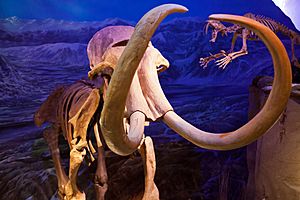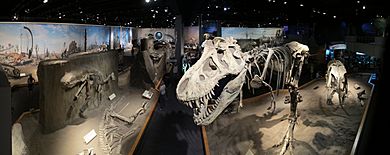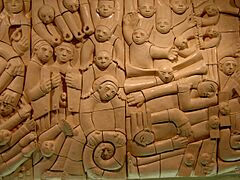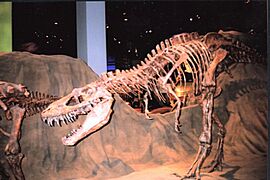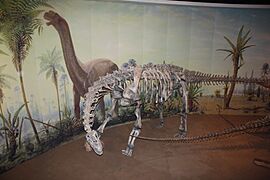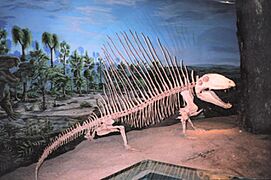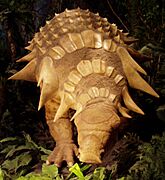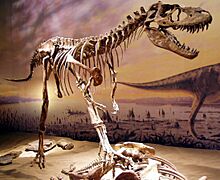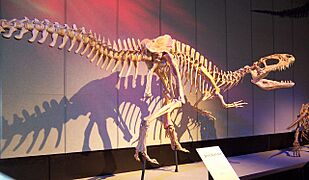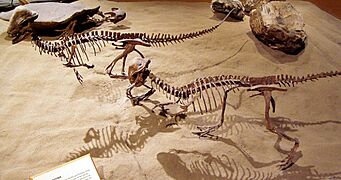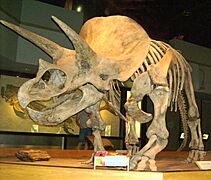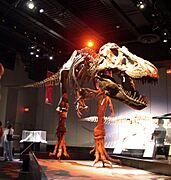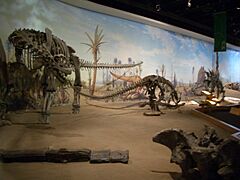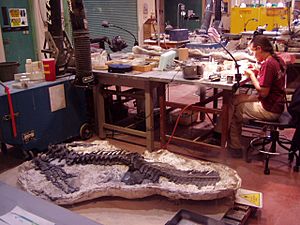Royal Tyrrell Museum of Palaeontology facts for kids
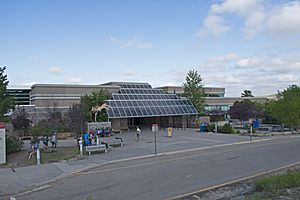
Entrance to the Royal Tyrrell Museum
|
|
| Former name | Tyrrell Museum of Palaeontology (1985–1990) |
|---|---|
| Established | 25 September 1985 |
| Location | 1500 N Dinosaur Trail, Drumheller, Alberta, Canada |
| Type | Palaeontological |
| Visitors | 470,000 (2016–17) |
| Architect | BCW Architects |
| Owner | Government of Alberta |
The Royal Tyrrell Museum of Palaeontology (often called the Royal Tyrrell Museum) is a cool museum and research center in Drumheller, Alberta, Canada. It's all about palaeontology, which is the study of ancient life, like dinosaurs! The museum is named after Joseph Burr Tyrrell, who was a geologist. It's located in Midland Provincial Park and has a big building designed by BCW Architects.
The idea for a palaeontology museum started in 1981. The Royal Alberta Museum's dinosaur experts and their fossil collection moved to help create this new museum. After four years of hard work, the Tyrrell Museum of Palaeontology opened in September 1985. Later, in June 1990, Queen Elizabeth II gave it the special title "royal." So, it became the Royal Tyrrell Museum of Palaeontology. The museum building has grown bigger twice since the year 2000, once in 2003 and again in 2019.
The museum has an amazing collection of over 160,000 fossils! This includes more than 350 holotypes, which are the first fossils used to describe a new species. This makes it the largest fossil collection in Canada. About 800 fossils from this huge collection are on display for everyone to see. Besides showing off fossils, the museum also uses its collection for important research. They study the history of Earth's geology and ancient life.
Contents
Discovering Ancient Life

In the late 1970s, the government of Alberta thought about building a museum near Dinosaur Provincial Park. In 1981, they officially announced plans for a palaeontology museum. But instead, it was built in Midland Provincial Park near Drumheller. This museum was part of a bigger plan by Premier Peter Lougheed. He wanted to create a network of museums and learning centers in smaller towns across Alberta. The government spent C$30 million to build it. David Baird, the museum's first director, was a key person in making it happen.
The Royal Alberta Museum's palaeontology team, their fossils, and many staff members moved to help start the new museum in 1981. Before the museum opened, its working name was the Palaeontological Museum and Research Institute. But David Baird changed it to the Tyrrell Museum of Palaeontology. This was to honor Joseph Tyrrell, a geologist who worked for the Geological Survey of Canada. Joseph Tyrrell accidentally found the first reported dinosaur fossil in the Red Deer River valley in 1884 while looking for coal.
The Tyrrell Museum of Palaeontology opened its doors to the public on September 25, 1985. That same year, the museum joined the China-Canada Dinosaur Project. This was their first big research project with another country. It was also the first important teamwork between Chinese and western palaeontologists since the Chinese Communist Revolution.
On June 28, 1990, the museum got a special honor from Queen Elizabeth II. It was given the title "royal," and its name changed to the Royal Tyrrell Museum of Palaeontology. In 1993, a volunteer group called the Royal Tyrrell Museum Cooperating Society was formed. This group helps fund research, publications, and other museum events.
In 2003, the museum added a major new part to its building, called the ATCO Tyrrell Learning Centre.
More plans to make the museum bigger started around 2013. The museum officially announced these plans in 2016. This expansion added a learning lounge annex, making the building 1,300 square meters (about 14,000 square feet) larger. The learning lounge was built because visitors wanted more hands-on activities. The provincial and federal governments helped pay for this expansion, which cost about C$9.3 million. The new learning lounge opened on June 28, 2019.
Museum Location and Building

The Royal Tyrrell Museum is located on North Dinosaur Trail in Midland Provincial Park, Drumheller, Alberta. The area around the museum is famous for its fossils. It sits in the middle of the Late Cretaceous Horseshoe Canyon Formation, which is full of fossil-bearing rock layers. There's also a 1.4-kilometer (about 0.87-mile) hiking trail called the Badlands Interpretive Trail northeast of the museum. The museum uses this trail a lot for its public and school programs.
Museum Building Design
The museum building was designed to be both a museum and a research lab. The first part of the building was finished in 1985. It has been expanded twice since then. The original building and its first expansion cover about 11,240 square meters (121,000 square feet) of space. About 4,400 square meters (47,000 square feet) of this is exhibit space. The second expansion, the learning lounge, added about 1,300 square meters (14,000 square feet). This brings the total size of the museum building to about 12,500 square meters (135,000 square feet).
The original building was designed by BCW Architects from Calgary, with Doug Craig as the main architect. He had to make sure the building fit in with the surrounding badlands landscape. The main building has several galleries with interactive displays, a cafeteria, a gift shop, and a theater. In the main lobby, there's a large ceramic mural called The Story of Life, created by Lorraine Malach.
In 2003, the museum hired BCW Architects again to design the ATCO Tyrrell Learning Centre. This new part of the museum, about 1,485 square meters (16,000 square feet), has classrooms with special technology. This technology lets researchers connect with field sites from far away. It also has a laboratory. The learning center was made for students from elementary school to university.
In 2019, the museum finished building the learning lounge. This expansion was designed by Kasian Architecture, along with the museum and the government of Alberta. It made the Distance Learning Studio and washrooms bigger. It also added more classrooms, lab spaces, an interactive learning lounge, and other multi-purpose rooms.
What You Can See: Exhibits
As of 2020, the museum has thirteen exhibits. They show about 800 fossils permanently. You can find information about the exhibits through videos, interactive computers, and displays. There are also cool artworks by Vladimir Krb in the exhibits.
Many exhibits are organized by different time periods in Earth's history, called geologic eras. These include the Cenozoic Gallery, Cretaceous Alberta, Cretaceous Garden, Palaeozoic Era, and Terrestrial Palaeozoic. The Cretaceous Alberta exhibit has a diorama (a 3D scene) of an Albertosaurus pack. This scene is inspired by 22 Albertosaurus fossils found together in Alberta. It's a tribute to Joseph Tyrrell, who first discovered this dinosaur.
Some exhibits focus on specific places or special fossil sites. For example, there's the Burgess Shale exhibit. The Grounds for Discovery exhibit shows fossils found during construction or industrial digs. The world's best-preserved thyreophora (a type of armored dinosaur) is in this exhibit. It's a fossil of a Borealopelta found by oil sand workers in the Athabasca oil sands.
Other exhibits with fossils from the museum's collection include the Dinosaur Hall, Fossils in Focus, and Triassic Giants. The Dinosaur Hall has over thirty mounted dinosaur skeletons. These include Albertosaurus, Camarasaurus, Triceratops, and a Tyrannosaurus. One famous Tyrannosaurus skeleton here is "Black Beauty," which is one of the most complete Tyrannosaurus skeletons ever found. Fossils in Focus shows fossils that are important for the museum's research. Triassic Giants is an exhibit dedicated to Elizabeth Nicholls, a former museum expert on marine reptiles. It features a Shonisaurus fossil, which is the world's largest marine reptile.
Besides exhibits with fossils, the museum also has two exhibits about the study of palaeontology itself: Foundations and Preparation Lab. In the Preparation Lab, you can watch technicians carefully prepare fossils for display or research. The Cretaceous Garden exhibit is designed to look like Alberta during the Cretaceous era. It has living plants that are related to the plants that grew there millions of years ago. The Learning Lounge, which opened in 2019, is the museum's newest exhibit. It's a hands-on area with an Albertosaurus statue and interactive displays about how dinosaurs ate, moved, and lived.
Gallery
-
The Story of Life, Lorraine Malach, 2003. On display at the museum's lobby
-
An Albertosaurus and a Euoplocephalus on display
-
Camarasaurus on display
-
Chasmosaurus found in Dinosaur Provincial Park on display
-
Dimetrodon on display
-
Edmontonia model on display
-
Gorgosaurus on display
-
Ornitholestes on display
-
Two Stegoceras on display
-
Triceratops on display
-
Tyrannosaurus on display
-
Jurassic section
The Museum's Fossil Collection
As of 2020, the museum's collection has over 350 holotypes and about 160,000 cataloged fossils. This makes it the largest fossil collection in Canada. As of November 2021, the museum's collection holds five Guinness World Records because of its unique fossils. These include the best-preserved Borealopelta and an Albertonectes fossil with the longest neck ever recorded.

Fossils from the collection are used for research or for museum exhibits. Only about 0.5 percent of the collection is on display in the museum's exhibits.
About half of these fossils are from the Cretaceous period. Most of them come from Alberta, with about 85 percent collected by the museum's own fieldwork. The museum also has fossils from the Palaeocene of Alberta, the Palaeozoic of the Canadian Arctic, and the Palaeozoic, Triassic, and Early Cretaceous of British Columbia.
Besides finding fossils themselves, the museum also gets items for its collection in other ways. These include donations, exchanges, purchases, and rescuing fossils from industrial digs. About 3,000 new fossils are added to the collection every year.
Museum Programs and Research
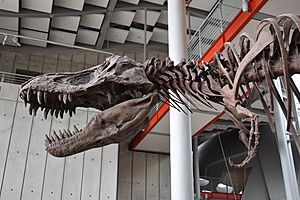
The museum staff offers guided tours of Midland Provincial Park. The museum also has outreach programs. These programs give students hands-on training in the field. They also offer "pay-to-dig" programs in the Drumheller area, where people can help dig for fossils in bonebeds. The museum also has online learning programs for students.
The museum has a special program where it makes copies of its fossils. These copies are then given to other museums to use.
Fossil Research
The museum's research program has a big job: to study and record the geological and palaeontological history of Alberta. The museum's research team includes palaeontologists, as well as visiting researchers and students. The museum's palaeontological technicians help with fieldwork and prepare fossils for exhibits or research. In 2015, the museum's technicians had over 150 years of combined experience!
Most of the research papers written by the museum's team are about vertebrates (animals with backbones). They have also published some papers on plants and invertebrates (animals without backbones). The discoveries from their research are often added to the museum's exhibits and educational programs.
The museum's research team started in the early 1980s. Their first job was to find fossils for the museum's exhibits and collections. Once they had enough, the researchers focused on studying the geology and fossils of Midland Provincial Park, Dinosaur Provincial Park, and other areas in Alberta. Since 1987, the museum has had a permanent field station at Dinosaur Provincial Park. The museum's research program has also done fieldwork in other parts of Canada, like British Columbia, the Canadian Arctic, Manitoba, and Saskatchewan.
The museum works with many other institutions on research projects. These include the Geological Survey of Canada, the Institute of Vertebrate Paleontology and Paleoanthropology, other museums in North America, and universities in Alberta. Many of their research projects are in Alberta, but they also do projects outside the province. As of 2015, the museum had participated in 10 collaborative research projects outside Alberta. The first was the Sino-Canadian Dinosaur Project in 1985. These projects have led to over 75 research publications.
See also
 In Spanish: Museo Tyrrell para niños
In Spanish: Museo Tyrrell para niños
- List of museums in Alberta
- List of natural history museums
- World's Largest Dinosaur, a big dinosaur statue in Drumheller



